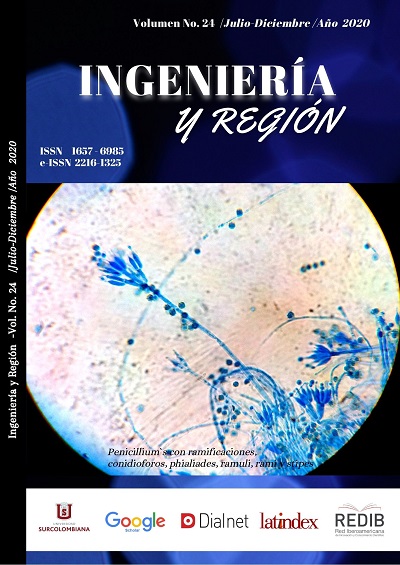Statistical analysis methods with scattered data
##plugins.themes.bootstrap3.article.main##
Downloads
##plugins.themes.bootstrap3.article.details##
Barrientos MRE, Cruz RN, Acosta MHG, Rabatte SI, Gogeascoechea TMC, Pavón LP, Blázquez Morales SL. Árboles de decisión como herramienta en el diagnóstico médico. Revista Médica de la Universidad Veracruzana. N. 2. 2009.
Cybenko, George. Approximation by Superpositions of a Sigmoidal Function. Mathematics of control, signals, and systems, 2, 303–314. 1989. https://doi.org/10.1007/bf02551274
Dong,G. Taslimitehrani, V. Pattern-aided regression modeling and prediction model analysis. IEEE Transactions on Knowledge and Data Engineering. P. 2452-2465. 2015. https://doi.org/10.1109/tkde.2015.2411609
Dunham, M. Data Mining Introductory and Advanced Topics. Prentice Hall. 2003.
Fayyad, U.M. and Irani, K.B. Multi-Interval Discretization of Continuous-Valued Attributes for Classification Learning. Proceedings of the 13th International Joint Conference on Artificial Intelligence (IJCAI-93), Chambèry, 28 August-3 September p1022-1027. 1993.
Galelli, S. Castelleti, A. Tree based iterative input variable selection hydrological modeling. Water Resourses Research. Vol 49 16 p. 2013. https://doi.org/10.1002/wrcr.20339
Garcia, J. Medina, H. Una revisión sobre las funciones de pedotransferencia en la determinación de las propiedades hidráulicas del suelo. Revista Ciencias Técnicas Agropecuarias. Vol 18 N. 3 2005. https://doi.org/10.35537/10915/39548
Ghanbarian, B., Taslimitehrani, V., Dong, G., & Pachepsky, Y. A. Sample dimensions effect on prediction of soil water retention curve and saturated hydraulic conductivity.Journal of Hydrology,528, 127-137. 2015. https://doi.org/10.1016/j.jhydrol.2015.06.024
Jana R B, Mohanty B P. Enhancing PTFs with remotely sensed data for multi-scale soil water retention estimation. J Hydrol. 399: 201–211. 2011. https://doi.org/10.1016/j.jhydrol.2010.12.043
Mao W and Wang F. Advances in intelligence and security informatics. Elsevier. Oxford UK. 103 p. 2012.
Matich, D. J. Redes Neuronales: Conceptos Básicos y Aplicaciones. Libro de clase. Informatica aplicada la ingeniería de procesos. Universidad Tecnológica Nacional facultad Regional Rosario Argentina. 2001.
Medina, R. Ñique, C. Bosques aleatorios como extensión de los árboles de clasificación con los programas R y Python. Interfasses. Ed N. 10. P 165-189. 2017. https://doi.org/10.26439/interfases2017.n10.1775
Minasny B, Hartemink A E. Predicting soil properties in the tropics. Earth-Sci Rev. 106: 52–62. 2011. https://doi.org/10.1016/j.earscirev.2011.01.005
Nemes A, Schaap M G, W¨osten J H M. Functional evaluation of edofotransfer functions derived from different scales of data collection. Soil Sci Soc Am J. 67: 1093–1102. 2003. https://doi.org/10.2136/sssaj2003.1093
Obiero, J. Gumbe, L. Omuto, C. Hassan, M. and Agullo, J. "Development of Pedotransfer Functions for Saturated Hydraulic Conductivity," Open Journal of Modern Hydrology, Vol. 3 No. 3, 2013, pp. 154-164. https://doi.org/10.4236/ojmh.2013.33019
Ortiz, A. Socha D. Aplicación de las redes neuronales MLP a la predicción de un paso en series de tiempo. Proyecto de grado. Fundación universitaria Konrad Lorenz. Facultad de ingeniería de sistemas. 2005. https://doi.org/10.4995/thesis/10251/64909
Pachepsky, Y. Rawls, W.J. Development of pedotransfer functions in soil hydrology. Developments in Soil Science Vol. 30. Editors book. Elsevier Science. 2004. https://doi.org/10.1016/s0166-2481(04)30023-1
Patil N G, Rajput G S, Nema R K, Singh R B. Predicting hydraulic properties of seasonally impounded soils. J Agr Sci Cambridge. 148: 159–170. 2010. https://doi.org/10.1017/s002185960999030x
Patil N G, Pal D K, Mandal C, Mandal D K. Soil water retention characteristics of Vertisols and pedotransfer functions based on nearest neighbor and neural networks approach to estimate AWC. J Irrig Drain Eng. 138: 177–184. 2011. https://doi.org/10.1061/(asce)ir.1943-4774.0000375
Patil N G, Singh S K. Pedotransfer functions for estimating soil hydraulic properties: A review. Pedosphere. 26(4): 417–430. 2016. https://doi.org/10.1016/s1002-0160(15)60054-6
Quinlan, J. R. Induction of decision trees. Mach. Learn., 1(1):81–106, March 1986
Quinlan J. R..C4.5: Programs for Machine Learning. Morgan Kaufmann Publishers Inc., San Francisco, CA, USA, 1993
Rodrigo, J. A. Árboles de predicción: bagging, random forest, boosting y C 5.0. Estadística con R. p 97, 2017.
Schaap, M. G. Leij, F. J. Database related accuracy and uncertainty of pedotransfer funtions. Soil Science 163. p 765 -–769. 1998. https://doi.org/10.1097/00010694-199810000-00001
Schaap, M.G., Leij, F. J., & Van Genuchten, M. T. ROSETTA: acomputer program for estimating soil hydraulic parameters with hierarchical pedotransfer functions. Journal of Hydrology, 251, 163–176. 2001. https://doi.org/10.1016/s0022-1694(01)00466-8
Stumpp C, Engelhardt S, Hofmann M, Huwe B. Evaluation of pedotransfer functions for estimating soil hydraulic properties of prevalent soils in a catchment of the Bavarian Alps. Eur J For Res. 128: 609–620. 2009. https://doi.org/10.1007/s10342-008-0241-7
Taslimitehrani, V. Guozhu Dong. A new CPXR based logistic regression method and clinical prognostic modeling results using the method on traumatic brain injury. IEEE International Conference on Bioinformatics and Bioengineering. P 283-290. 2014. https://doi.org/10.1109/bibe.2014.16
Tomasella J, Pachepsky Y, Crestana S, Rawls W J. Comparison of two techniques to develop pedotransfer functions for water retention. Soil Sci Soc Am J. 67: 1085–1092. 2003. https://doi.org/10.2136/sssaj2003.1085
Vásquez, J. P. Red Neuronal feedforward como estimador de patrones de corrientes en el interior del puerto de Manzanillo sujeto a la acción de tsunamis. Instituto Mexicano del Transporte. Publicación técnica 406. 63 p. 2014.
Vereecken H, Weynants M, Javaux M, Pachepsky Y, Schaap M G, van Genuchten M T. Using pedotransfer functions to estimate the van Genuchten-Mualem soil hydraulic properties: a review. Vadose Zone J. 9: 795–820. 2010. https://doi.org/10.2136/vzj2010.0045
Warner, Brad, & Misra, Manavendra. Understanding Neural Networks as Statistical Tools. The american statistician, 50(4), 284–293.1996. https://doi.org/10.1080/00031305.1996.10473554
Wehenkel, L. Ernst, D. and Geurts, P. Ensembles of extremely randomized trees and some generic applications. RTE-VT workshop, paris may 29-30 2006.
W¨osten J H M, Pachepsky Y A, Rawls W J. Pedotransfer functions: bridging the gap between available basic soil data and missing soil hydraulic characteristics. J Hydrol. 251: 123–150. 2001. https://doi.org/10.1016/s0022-1694(01)00464-4


















